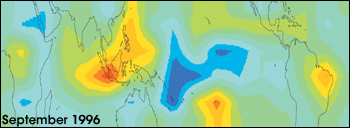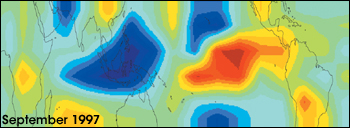| |
How is the Earth's climate changing?
Water vapor, carbon dioxide and other greenhouse gases trap infrared radiation that would otherwise escape to space. This phenomenon, the greenhouse effect, makes the Earth habitable. Increased atmospheric emissions from industrial and agricultural activities are causing climate change. Industry and agriculture produce trace gases that trap infrared radiation. The concentrations of many of these gases have increased and thus have added to the greenhouse effect. Since the turn of the century, the global mean lower tropospheric temperature has increased by more than 0.4°C. This increase has been greater than during any other century in the last 1,000 years.
Ozone plays multiple roles in climate change because it absorbs both ultraviolet radiation from the Sun and infrared radiation from the Earth’s surface. Tropospheric ozone is as important as methane as a greenhouse gas contributor to climate change. An accurate measurement of the distribution of tropospheric ozone will improve climate modeling and climate predictions.
Aerosols are an important but uncertain agent of climate change. Aerosols alter atmospheric temperatures by absorbing and scattering radiation. Aerosols can both warm or cool the troposphere, depending on their type and location. Therefore, aerosols also modify clouds and affect precipitation. Sulfate aerosols can reduce cloud droplet size, making clouds brighter so that they reflect more solar energy. Black carbon aerosols strongly absorb solar radiation, warming the mid-troposphere and reducing cloud formation. Poor knowledge of the global distribution of aerosols contributes to a large uncertainty in climate prediction.
Ozone absorbs solar radiation, warming the stratosphere. Man-made chlorofluorocarbons have caused ozone depletion, leading to lower temperatures. Low temperatures, in turn, lead to more persistent polar stratospheric clouds and cause further ozone depletion in polar regions.
Increasing carbon dioxide also affects the climate of the upper atmosphere. Where the atmosphere is thin, increasing CO2 emits more radiation to space, thus cooling the stratosphere. Observations show that over recent decades, the mid to upper stratosphere has cooled by 1 to 6°C (2 to 11°F) primarily due to increases in CO2. This cooling will produce circulation changes in the stratosphere that will change how trace gases are transported.
   Water vapor measurements from the Microwave Limb Sounder (MLS) onboard the Upper Atmospheric Research Satellite (UARS) show the contrast between 1996 (a "normal" year) and 1997 (an "El Niño" year). In 1996 the most convection and the highest mixing ratios for tropical upper tropospheric water vapor (red) occur over Indonesia; the lowest mixing ratios for tropical upper tropospheric water vapor (blue) occur in the eastern Pacific. In 1997 the sea surface temperatures in the tropical eastern Pacific are much warmer than in 1996, and the region of intense convection shifts eastward away from Indonesia. The situation is reversed in 1997 from 1996 with the highest mixing ratios for upper tropospheric water vapor in the eastern Pacific, and very low mixing ratios over Indonesia. (Images courtesy of William Read, NASA JPL). Water vapor measurements from the Microwave Limb Sounder (MLS) onboard the Upper Atmospheric Research Satellite (UARS) show the contrast between 1996 (a "normal" year) and 1997 (an "El Niño" year). In 1996 the most convection and the highest mixing ratios for tropical upper tropospheric water vapor (red) occur over Indonesia; the lowest mixing ratios for tropical upper tropospheric water vapor (blue) occur in the eastern Pacific. In 1997 the sea surface temperatures in the tropical eastern Pacific are much warmer than in 1996, and the region of intense convection shifts eastward away from Indonesia. The situation is reversed in 1997 from 1996 with the highest mixing ratios for upper tropospheric water vapor in the eastern Pacific, and very low mixing ratios over Indonesia. (Images courtesy of William Read, NASA JPL).
Water vapor is the most important greenhouse gas. Some measurements suggest that water vapor is increasing in the stratosphere. This increase may be due to changes in the transport of air between the troposphere and the stratosphere caused by climate change, or it could be due to changes in the microphysical processes within tropical clouds. More measurements of upper tropospheric water vapor, trace gases and particles are needed to untangle the cause-and-effect relationships of these various agents of climate change. We can verify climate models of the atmosphere only with global observations of the atmosphere and its changes over time.
What will Aura Do?
Aura will measure concentrations of greenhouse gases such as methane, water vapor, and ozone in the upper troposphere and lower stratosphere. Aura also will measure both absorbing and reflecting aerosols in the lower stratosphere and lower troposphere and water vapor measurements inside the high tropical clouds, and will make high vertical resolution measurements of some greenhouse gases in a broad swath across the tropical upwelling region. All of these measurements contribute key data for climate modeling and prediction.
next: HIRDLS
back: What are the processes controlling air quality?
|
|

|

